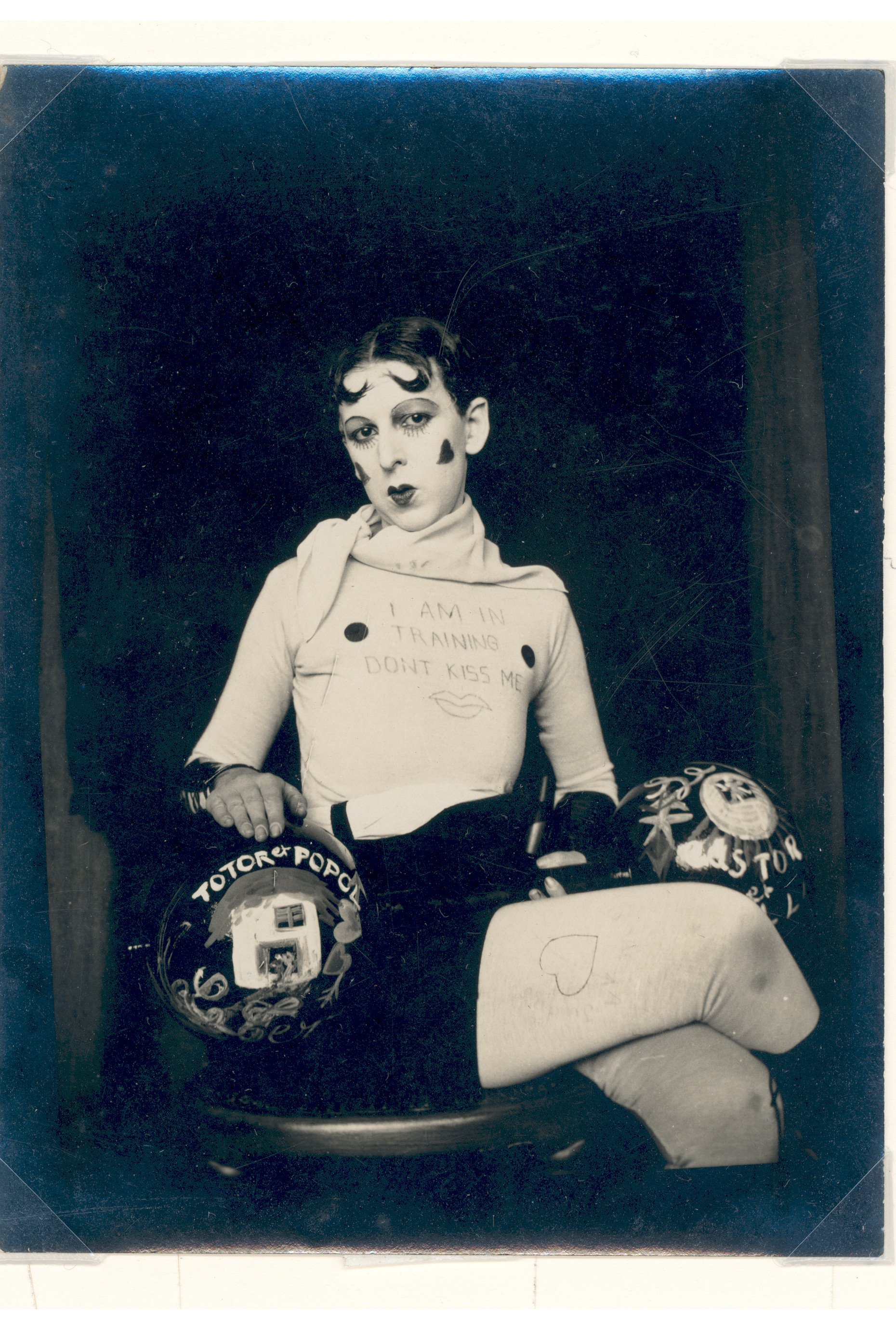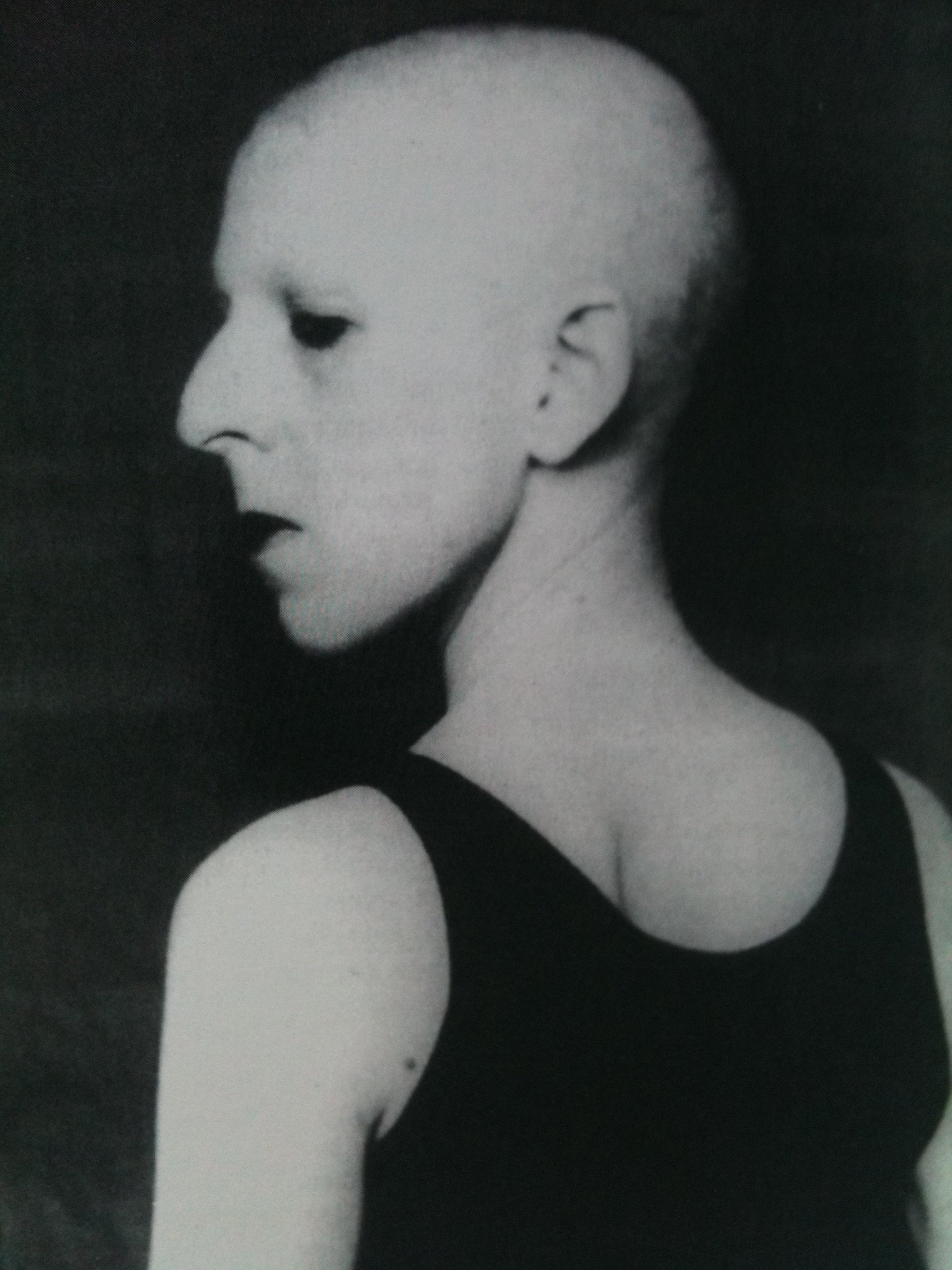Claude Cahun e Marcel Moore
La lama scivola veloce sul cranio rasato, Lucy si guarda allo specchio, il suo volto rimane ambiguo, si gira di profilo e tenta di intravedere il naso prominente che potrebbe trarre in inganno i più e farla scambiare per un uomo. “Chi sono?” pensa, poi ad alta voce “Cosa sono? Posso essere uomo posso essere donna, posso essere chi voglio… Scelgo io. Sono Claude. Sullo sfondo, in ombra dietro il cavalletto e la macchina fotografica c’è Marcel che la guarda con occhi sereni e complici”
Claude Cahun e Marcel Moore
Lucy Renée Mathilde Schwob (1894 – 1954), in arte Claude Cahun, è una di quelle donne che, all’inizio del ‘900, diventano icone dell’emancipazione femminile. Intelligente, indipendente, supportata dal padre sia dal punto di vista finanziario che educativo è stata un precursore dell’idea stessa di gender fluid.
Amica e sodale dei surrealisti, non solo produce ma riflette e interviene come critica e storica dalle pagine del prestigioso Mercure de France.
Proviamo a mettere ordine perché la vita di Claude Cahun è indissolubilmente legata a quella della sua compagna (il loro sodalizio inizia quando la prima ha 15 anni le seconda 17) di scorribande artistiche e di azioni di resistenza Suzanne Malherbe (1892 – 1972) che assumerà il nome d’arte di Marcel Moore.
Tutto quello che oggi sembra leggermente fuori dalla norma un po’ sopra le righe deve aver colpito una parte della società borghese come un ciclone. È facile immaginare che fuori dalla cerchia degli amici artisti Claude e Marcel siano state considerate scandalose e irrispettose dell’ordine sociale.
Claude nasce nel 1894 da una famiglia agiata di intellettuali, scrittori e proprietari di un quotidiano il Le Phare de la Loire. Lo zio è un noto scrittore simbolista e in famiglia si parla e discute d’arte, politica e nuove tendenze sociali, l’educazione che riceve è improntata all’universalità, alla curiosità la sua mente fresca la induce a riflettere, a scrivere a provare. Non le basta la parte teorica di osservatrice vuole partecipare alla scena artistica, ha molto da dire non vuole rimanere a bordo campo. Le amicizie del padre la agevolano nella relazioni con altri editori, pittori, scrittori. Claude assorbe, riflette, elabora.
La malattia mentale della madre che viene internata la allontana per un po’ da casa e vive per qualche tempo con la nonna. Nel 1909 al suo ritorno in famiglia, con il padre che ha trovato una nuova compagna, avviene qualcosa di alchemico: conosce e si innamora della sua sorellastra (la figlia della nuova compagna del padre) Suzanne Malherbe, un amore che durerà per tutta la vita ed oltre.
Risale al 1913 il primo auto ritratto sarà il l’inizio di un lunghissima serie che la accompagnerà per tutta la vita.
Nel 1917 i genitori si sposano e le due ragazze oramai vivono assieme. Sono anni di studio, scrittura, teatro, Claude diventa una apprezzata critica letteraria e d’arte, si avvicina al surrealismo, inizia a teorizzare una instabilità di genere, si rasa spesso il cranio si impossessa della simbologia maschile ai lavori fotografici seguono, nel 1925, quelli letterari con “Eroine” rivista la vita di alcune donne che hanno fatto la storia come Dalila, Salomè, Elena di Troia, Cenerentola e Saffo.
Negli anni trenta Claude è molto vicina André Breton che la definisce: “una delle menti più brillanti e curiose dei nostri tempi, aderisce alla Federazione degli Artisti Rivoluzionari Indipendenti che annovera fra le sue fila oltre al già citato Breton, Diego Rivera e Leon Trotsky.
Nel 1938, preoccupate per l’ascesa dell’antisemitismo in Europa si ritirano a Jersey nelle isole del canale che frequentano dal 1922, e lasciano Parigi.
Poi accade un fatto strano, nel 1940 i tedeschi dopo aver invaso la Francia occupano anche Jersey e Claude e Marcel iniziano a compiere piccoli atti di resistenza culturale, nascondo nelle riviste destinate alla truppe tedesche volantini inneggianti la libertà dei popoli con slogan anti nazisti firmati “il soldato senza nome”. Sono operazioni di resistenza simbolica raccontate nel libro di Jeffrey H. Jackson “Paper Bullets”. Per i nazisti sono crimini da perseguire e nel 1944 le due vengono arrestate e condannate a morte, sentenza che, fortunatamente non fu mai eseguita. Venero rilasciate nel 1945 con la liberazione dell’isola.
Rimarranno a Jersey dove nel 1954 a 60 anni Claude morirà, Marcel le sopravviverà fino al 1972 anno in cui deciderà di togliersi la vita.
In italiano esiste poco materiale, in francese ed in inglese c’è qualcosa di più.
Cahun fu un precursore del travestimento e dell’autoritratto pratica che verrà portata alla ribalta dell’arte contemporanea da Cindy Sherman.
English Version
The blade slides quickly on the shaved skull, Lucy looks in the mirror, her face remains ambiguous, she turns in profile and tries to glimpse the prominent nose that could deceive most and make her mistake for a man. "Who I am?" he thinks, then aloud “What am I? I can be a man I can be a woman, I can be whoever I want ... I choose. I'm Claude. In the background, in the shade behind the tripod and the camera, is Marcel who looks at her with serene and complicit eyes "
Lucy Renée Mathilde Schwob (1894 - 1954), aka Claude Cahun, is one of those women who, in the early 1900s, became icons of women's emancipation. Intelligent, independent, supported by her father both from a financial and educational point of view, she was a precursor of the very idea of gender fluid.
Friend and companion of the surrealists, she not only produces but reflects and intervenes as a critic and historian from the pages of the prestigious Mercure de France.
Let's try to put order because the life of Claude Cahun is inextricably linked to that of his partner (their partnership begins when the first is 15 and the second 17) of artistic raids and resistance actions Suzanne Malherbe (1892 - 1972) who will take on the stage name of Marcel Moore.
Everything that today seems slightly out of the ordinary a little over the top must have hit a part of bourgeois society like a cyclone. It is easy to imagine that outside the circle of artist friends Claude and Marcel were considered scandalous and disrespectful of the social order.
Claude was born in 1894 into a wealthy family of intellectuals, writers and owners of a newspaper, Le Phare de la Loire. The uncle is a well-known symbolist writer and in the family we talk and discuss about art, politics and new social trends, the education she receives is marked by universality, her fresh mind leads her to reflect, to write and try to curiosity. . The theoretical part of the observer is not enough for her, she wants to participate in the art scene, she has a lot to say and she doesn't want to stay on the sidelines. Her father's friendships facilitate her relationships with other publishers, painters, writers. Claude absorbs, reflects, elaborates.
The mental illness of the mother who is interned keeps her away from her father for a while. In 1909, on his return to the family with his father who has found a new partner, something alchemical happens: he meets and falls in love with his half-sister (the daughter of his father's new partner) Suzanne Malherbe, a love that will last for a lifetime and beyond.
The first self-portrait dates back to 1913 and will be the beginning of a very long series that will accompany her throughout her life.
In 1917 the parents got married and the two girls now live together. These are years of study, writing, theater, Claude becomes an appreciated literary and art critic, approaches surrealism, begins to theorize a gender instability, often shaves his skull and takes possession of male symbolism to the photographic works followed, in 1925 , the literary ones with “Heroines” revisiting the lives of some women who have made history such as Delilah, Salome, Helen of Troy, Cinderella and Sappho.
In the thirties Claude is very close to André Breton who defines her: “one of the brightest and most curious minds of our times, he joins the Federation of Independent Revolutionary Artists which counts among its ranks in addition to the aforementioned Breton, Diego Rivera and Leon Trotsky.
In 1938, worried about the rise of anti-Semitism in Europe, they retreated to Jersey in the channel islands they had frequented since 1922, and left Paris.
Then a strange fact happens, in 1940 the Germans after invading France also occupy Jersey and Claude and Marcel begin to carry out small acts of cultural resistance, hiding leaflets praising the freedom of peoples with signed anti-Nazi slogans in the magazines intended for the German troops " the soldier without a name ". They are operations of symbolic resistance told in Jeffrey H. Jackson's book "Paper Bullets". For the Nazis these are crimes to be prosecuted and in 1944 the two were arrested and sentenced to death, a sentence which, fortunately, was never carried out. They were released in 1945 with the liberation of the island.
They will remain in Jersey where in 1954 Claude will die at the age of 60, Marcel will survive her until 1972 when he decides to take his own life.
In Italian there is little material, in French and in English there is something more.
Cahun was a forerunner of disguise and self-portrait.







